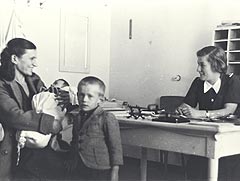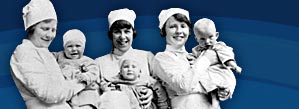Conception
The revolutionary aspect of the NHS was that it extended services freely to everyone.
By 1939 only around half of all Scots had a GP. This was mainly based on the “panel” system under which the working population who paid insurance contributions could choose their doctor from a local panel.
This meant half the population did not have access – mainly women and children but overwhelmingly the poor. Free hospital treatment was available at most voluntary hospitals. But as of charity not of right. And it was no safety net:
“A patient in Craigmillar told me of a friend of his in the early 1930s whose little daughter became extremely ill. He was far too poor to be able to call in a doctor or even to pay for a journey by bus.
“The only thing he could do was take his daughter in his arms and walk the five or six miles up to the Royal Infirmary. When he arrived there he found his daughter was dead.”
Sir John Crofton
Basic rations
Gross inequalities between the haves and the have-nots were brought into sharp focus with the advent of war in 1939.
Food rationing was introduced on a nutritional model supplied by Sir John Boyd-Orr, a student of Edward Cathcart, and the founder of the Rowett Institute in Aberdeen.
Boyd-Orr had seen for himself the horrors of abject poverty in Glasgow. Ensuring everyone had the basic minimum meant that the poorest families in Britain for the first time had a decent basic diet.
The Beveridge Report
In 1942 Sir William Beveridge set out his vision of a post-war Welfare State to banish from Britain the five evil giants – want, ignorance, squalor, idleness and disease.
Beveridge (1879-1963) was a respected academic and former director of the London School of Economics.
The report might have been destined to be another dry and dusty Government document. What made it a huge public best seller was its breathtaking vision and passionate language. The fiery rhetoric largely came from Scotland after weekends spent with Jessy Mair in the spring and summer of 1942.
Jessy was Beveridge’s close confidante and companion for many years. His biographer, Jose Harris, highlights her influence on him during his visits north of the border where she was staying with relatives in Scotland:
“Much of his report was drafted after weekends with her in Edinburgh and it was she who urged him to imbue his proposals with a ‘Cromwellian spirit’ and messianic tone. ‘How I hope you are going to preach against all gangsters,’ she wrote. ‘who for their mutual gain support one another in upholding all the rest. For that is really what is happening still in England’. . . .”
Beveridge didn’t miss. Uniquely for a Government report, it sold 100,000 copies within a month. Special editions were printed for the forces.
Jessy was the wife of his civil servant cousin, David Mair. She and Beveridge married soon after his death in 1942. Elected as MP for Berwick upon Tweed in 1944 but unseated in the election the following year, Beveridge later became leader of the Liberals in the House of Lords.
- Further information
- Beveridge

“One of the most important criticisms of the organisation as it exists at present is that advice and treatment are not immediately accessible to every individual unless the payment of medical fees is a matter of little or no moment.
“This fact has been brought home to me on numerous occasions when visiting in the district for purposes of housing. During the winter months particularly, one finds in numerous dwelling houses children who are obviously ill and in need of medical attention.
“No doctor is in attendance, and the reason is always connected with finance. . . . In the diphtheria wards of the Fever Hospital, every now and again, a child is admitted suffering from diphtheria in an advanced stage of the disease, too late to expect successful results from the specific remedy.
“Usually we find there has been delay in sending for medical advice owing to the expenditure involved.”
Dr WL Burgess, Medical Officer for Health for Dundee, Cathcart Report, 1936
